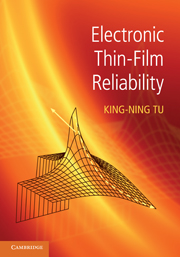Book contents
- Frontmatter
- Dedication
- Contents
- Preface
- 1 Thin-film applications to microelectronic technology
- 2 Thin-film deposition
- 3 Surface energies
- 4 Atomic diffusion in solids
- 5 Applications of the diffusion equation
- 6 Elastic stress and strain in thin films
- 7 Surface kinetic processes on thin films
- 8 Interdiffusion and reaction in thin films
- 9 Grain-boundary diffusion
- 10 Irreversible processes in interconnect and packaging technology
- 11 Electromigration in metals
- 12 Electromigration-induced failure in Al and Cu interconnects
- 13 Thermomigration
- 14 Stress migration in thin films
- 15 Reliability science and analysis
- Appendix A A brief review of thermodynamic functions
- Appendix B Defect concentration in solids
- Appendix C Derivation of Huntington's electron wind force
- Appendix D Elastic constants tables and conversions
- Appendix E Terrace size distribution in Si MBE
- Appendix F Interdiffusion coefficient
- Appendix G Tables of physical properties
- Index
- References
12 - Electromigration-induced failure in Al and Cu interconnects
Published online by Cambridge University Press: 05 July 2014
- Frontmatter
- Dedication
- Contents
- Preface
- 1 Thin-film applications to microelectronic technology
- 2 Thin-film deposition
- 3 Surface energies
- 4 Atomic diffusion in solids
- 5 Applications of the diffusion equation
- 6 Elastic stress and strain in thin films
- 7 Surface kinetic processes on thin films
- 8 Interdiffusion and reaction in thin films
- 9 Grain-boundary diffusion
- 10 Irreversible processes in interconnect and packaging technology
- 11 Electromigration in metals
- 12 Electromigration-induced failure in Al and Cu interconnects
- 13 Thermomigration
- 14 Stress migration in thin films
- 15 Reliability science and analysis
- Appendix A A brief review of thermodynamic functions
- Appendix B Defect concentration in solids
- Appendix C Derivation of Huntington's electron wind force
- Appendix D Elastic constants tables and conversions
- Appendix E Terrace size distribution in Si MBE
- Appendix F Interdiffusion coefficient
- Appendix G Tables of physical properties
- Index
- References
Summary
Introduction
While electromigration is the most persistent reliability problem in interconnects of microelectronic devices, it does not necessarily lead to microstructure failure. In interconnect regions where electromigration is uniform and steady, there may not be microstructure damage. While atoms are being driven from the cathode to the anode and vacancies are being driven in the opposite direction at the same time, no void or hillock occurs as long as the vacancy distribution is in equilibrium and the source and sink of vacancies are effective at the anode and the cathode, respectively. Only if vacancy distribution is not at equilibrium in electromigration will it lead to microstructure failure such as void and extrusion formation. The occurrence of these failures must involve atomic flux divergence and change in total number of lattice sites. It is a time-dependent reliability problem [1–5].
We have discussed in Chapter 11 that the Blech structure of short strips can show electromigration failure directly. This is because the short strips have the built-in divergence of atomic flux at the two ends, where atoms of Al cannot diffuse out of Al into the TiN-based line, nor from the TiN into the Al. Thus, atomic flux divergence is a necessary condition of electromigration-induced damage. Sometimes voids or hillocks are found in the middle of a strip where the electric current seems uniform, but they are due to flux divergence in the middle of the line caused by triple points of grain boundaries or other kinds of structural defect.
- Type
- Chapter
- Information
- Electronic Thin-Film Reliability , pp. 270 - 288Publisher: Cambridge University PressPrint publication year: 2010



